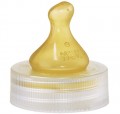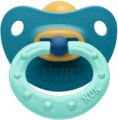Shape
The general shape of a pacifier or pacifier (see "Type").
-
Round. The classic round shape is convenient because the pacifier can be given in any direction. Yes, these models are the cheapest. On the other hand, it is believed that long-term use of a round nipple can lead to a malocclusion.
-
Anatomical. The papilla on the anatomical nipple or pacifier is flattened or elongated, most often it has the shape of an ellipse. It is believed that such products evenly distribute the pressure on the palate, contribute to the formation of a correct bite and prevent the swallowing of air.
-
Orthodontic. A nipple/dummy with a beveled papilla, flattened at the bottom and convex at the top. This form is considered the most correct in terms of anatomy and physiology, but also in terms of convenience for the child (although this moment, of course, is individual). An orthodontic nipple/pacifier takes up minimal space in the mouth, reduces the risk of tooth and palate deformity to almost zero, and contributes to the formation of a correct bite.
Note that when choosing a shape, it is worth considering not only theoretical recommendations, but also the preferences of the baby himself. It happens that an orthopedic or anatomical model that is perfect in shape (theoretically) simply does not like the child, and the simplest round dummy turns out to
...be the most desirable option. That is why all three forms are still relevant.Bottle neck size
The size of the bottle neck for which the pacifier is designed (see "Type").
Baby bottles are available in two standard neck sizes —
standard and
wide. The size of the pacifier must match the diameter of the neck, otherwise it will not be possible to use the product normally with this bottle.
In box
Additional items included in the design or delivery of the pacifier/pacifier.
—
Cap. Protective cap that can be put on the nipple during non-working hours. This greatly simplifies the storage of the product: the cap protects against contamination and may be useful even if the nipple / pacifier is simply lying in an open place (because dust can settle on it), not to mention troubles like falling on the floor. However, the cap is suitable only for a short stay in the open; for long-term storage, it is better to use a container (see below) or at least an impromptu case.
—
Ring. The handle in the form of a ring is equipped exclusively with pacifiers. Such a handle is convenient for parents — in particular, you can quickly and effortlessly remove the pacifier from your mouth, even if the child actively objects to this. At the same time, pacifiers without a ring are also available — they are more compact and better suited for active babies who may not release their nipples while on the move.
—
Chain. A device for hanging a pacifier around the neck (only they are equipped with chains, such equipment does not make sense for nipples). Note that the name "chain" is conditional, most often it is not a metal chain (uncomfortable or even dangerous for a child), but a narrow ribbon made of soft fabric.
—
Container.... Special container for storing and carrying nipples/pacifiers. Like the cap described above, it is primarily intended to protect against contamination; the pacifier/pacifier fits into the container as a whole, making this option perfect for long-term storage. Of course, improvised packaging can also be used for such storage; however, a complete container is generally more convenient and hygienic.
— Additional nozzle / mesh. Optional silicone cap or mesh supplied with nibbler (see "Type"). As you use the nibblers inevitably wear out, besides, the child can simply chew on the nozzle. Instead of buying a new nibbler, it is easier and cheaper to change its working part; the presence of a nozzle / mesh in the kit eliminates the need to buy a replacement part separately. This is especially convenient for silicone nibblers — spare nozzles for them are quite rare on the market.
